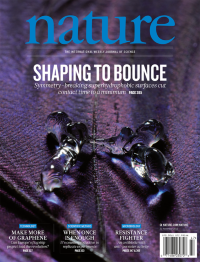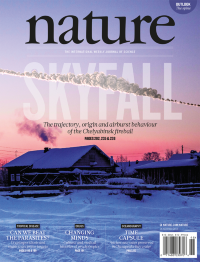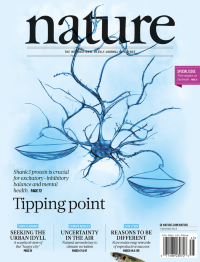Volume 503
-
No. 7477 28 November 2013
The cover illustrates an oxide crystal generating electric current from incoming light. The spontaneous electrical polarization that characterizes a ferroelectric material is attractive for solar-cell applications as the positive and negative charges generated by light absorption have a natural tendency to separate, making them easier to harvest efficiently. Unfortunately most known ferroelectrics have wide electronic bandgaps � that is they absorb only higher energy photons that make up a small fraction of the solar spectrum. Ilya Grinberg and colleagues now show that a classic ferroelectric can be chemically engineered to tune the bandgap over a broad range, achieving strong absorption and photocurrent generation across the solar spectrum. (Cover by Felice Macera)
-
No. 7476 21 November 2013
A water drop strikes the water-averse wing of a Morpho butterfly. There are many uses for surfaces that can stay dry, self-clean or resist icing. Liquid drops hitting such surfaces tend to spread out and then retract before finally bouncing. Many applications benefit from minimizing the contact time between drop and surface, which is generally assumed to occur if the impacting drop deforms symmetrically. Kripa K. Varanasi and colleagues now show that drops bounce off faster from a superhydrophobic surface with a morphology that redistributes the liquid mass so that it no longer spreads and retracts symmetrically. Theory and experiments confirm that this strategy shortens the contact time between a bouncing drop and a surface beyond what was thought possible. Photo: A. T. Paxson, K. Hounsell, J. W. Bales, J. C. Bird & K. Varanasi.
-
No. 7475 14 November 2013
The fireball that streaked across the skies above Chelyabinsk in Russia on 15 February 2013 is providing astronomers with a wealth of information. Two papers in this issue present detailed reconstructions of the Chelyabinsk event. From an analysis of videos, Jiř� Borovička et al. determined the trajectory and velocity of the superbolide with high precision. Its orbit was similar to that of the 2-kilometre-diameter asteroid 86039 (1999 NC43), suggesting that the two bodies may be part of the same asteroid family. And they show that it broke into small pieces between the altitudes of 45 and 30 kilometres. In the companion paper, Peter Brown et al. analysed the damage caused by the airburst which they estimate was equivalent in energy to the detonation of 400 to 600 kilotons of TNT. They suggest that the number of impactors with diameters of tens of metres was an order of magnitude higher than current estimates, shifting much of the residual impact risk to these sizes. On the cover, a 3D simulation by Mark Boslough using CTH code on Sandia National Laboratories� Red Sky supercomputer, rendered by Brad Carvey using Houdini FX and LightWave; background photo by Olga Kluglova, go.nature.com/wxuV58.
Nature Outlook
-
No. 7474 7 November 2013
Mutations in SHANK3, the gene encoding the SHANK3 synaptic scaffolding protein, are associated with autism, intellectual disability and schizophrenia, but the effect of SHANK3 overexpression is much less clear. Huda Zoghbi and colleagues now show that mice overexpressing Shank3 exhibit mania-like behaviour, seizures and alterations in excitatory/inhibitory balance of neuronal activity. Consistent with the findings in mouse, they identify two patients with hyperkinetic disorders carrying a genetic duplication of the SHANK3-containing region on chromosome 22. These findings support the hypothesis that incorrect gene dosage in either direction (both over- and under-expression) may be detrimental. The authors suggest that the mice used in this work provide a model for the pharmacogenetic underpinnings of some forms of bipolar disorder. Cover: Wei-Hisang Huang.




